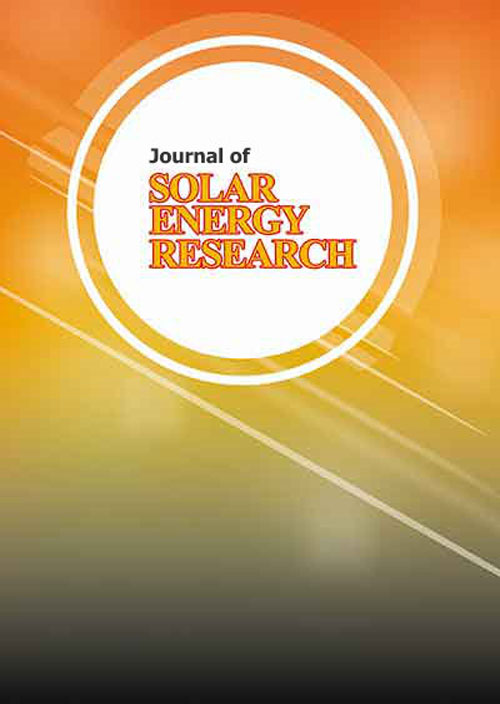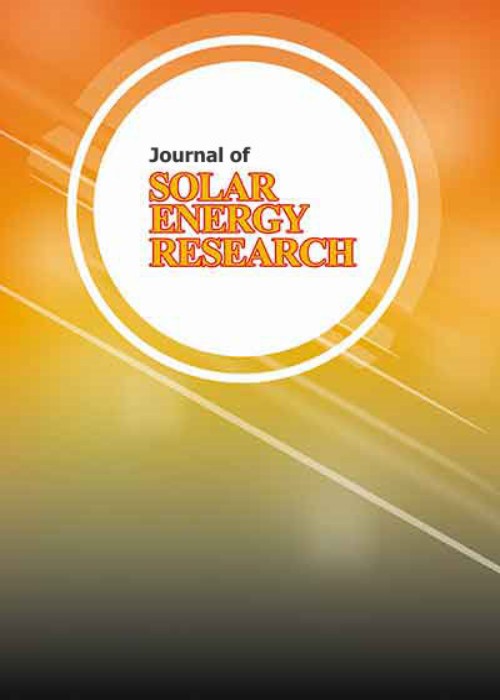فهرست مطالب

Journal of Solar Energy Research
Volume:7 Issue: 4, Autumn 2022
- تاریخ انتشار: 1401/07/26
- تعداد عناوین: 5
-
-
Pages 1134-1142Water heaters are important tools to use solar energy, as one of the main renewable energy sources, for increasing water temperature. The present research was conducted to predict the outlet fluid temperature of a solar water heater with a flat plate collector by the computational fluid dynamics method. Initially the ambient temperature, the temperature of the inlet and outlet fluid, and the temperature of the collector were experimentally measured from 10 am to 18 pm every two hours. The fluid flow tubes of the flat plate solar collector were simulated in the ANSYS Fluent Software. The temperature of the outlet fluid was calculated based on the measured variables by the computational fluid dynamics method. For that, k-ε turbulent model was used for simulating the collector in the software. A validation was carried out between experimental data and numerical results. The results of the simulation showed that computational fluid dynamics can predict the outlet fluid temperature with errors between 1 to 22%. In most cases, the predicted temperatures were higher than those of experimented data and higher errors were observed for higher flow rates.Keywords: Solar energy, Flat plate solar collector, Computational Fluid Dynamics, Fluid temperature
-
Pages 1143-1158
Rural Health Centers (RHCs) are nationally crucial points of interests, requiring electricity to continue storing drugs, offering health services, performing minor and outpatient surgeries, and other health services under any circumstances. With outbreaks such as COVID-19, constant power supply has become a challenging endeavor in Iran craving more attention. Accordingly, this research aimed at finding an optimum combined heat and power (CHP) system using renewable energies (wind, solar, and animal biomass) for the first time in a RHC in Iran. Different hybrid scenarios were evaluated and ranked in HOMER v2.81. The techno-economic-environment-energy performance of vortex turbines were assessed, for the first time, and were then added to the software database. The results showed that the top three scenarios are solar cell-battery (first scenario), solar cell-biomass-battery (second scenario), and solar cell-wind turbine-battery (third scenario) with levelized cost of energy (LCOE) of 0.393, 0.406, and 0.468 $/kWh, respectively. In the top economic scenario, 25% of the required energy was generated by solar cells and the rest by gas boiler that producing 7,050 kg of CO2 annually. In the third scenario, the most environmentally friendly one, CO2 was reduced by about 60 kg compared to the first scenario. Another important point is the important role of dump load in converting excess electricity into heat, contributing to 20% of the generated heat in the first scenario. Based on the results, the authors suggest focusing on solar energy in the studied region given its higher economic potential than wind and biomass energies.
Keywords: Rural healthcare, CHP, HOMER software, Vortex bladeless, Excess electricity -
Pages 1159-1173Notwithstanding the reported hazardous effect of combustion of fossil fuel on humans and the environment, and the established viability of renewable energy source (in this case solar) as alternative sources of electricity in Nigeria; there seems to be increasing subscription to fossil fuel powered generators amongst regular university students living off campus. Beyond functionality and safety, the economic implication of acquiring and running an energy generating source seems to contribute significantly in the decision to adopt same. Similarly, student’s propensity to choose an alternative electricity supply source is supposedly affected by this factor. There is therefore need for economic based analysis of the alternative sources. The results of an online based survey among the students and a mini experiment served as basis for and input data in the analysis. The cost implications as at the time of this research were obtained from local vendors, classified and used in the analysis. Net present worth, net annual worth, benefit-cost ratio and return on investment were measures employed in the analysis, and decision making was based on the set criteria. The result of the analysis shows that the challenger (solar photovoltaic system) could be more economical than the defender (fossil fuel powered generators) for the 5 years’ study period, if the current electricity load of the selected student’s room is optimized.Keywords: Solar energy, renewable energy, Economic Analysis, Fossil fuel
-
Pages 1174-1187Solar chimneys are classified as a passive way of using solar power to provide a comfortable atmosphere inside buildings without requiring any mechanical devices. In this study, the use of solar chimneys to generate a steady air flow inside the building in order to reduce the temperature and increase the air quality was investigated. To reduce the temperature, the evaporative cooling by spraying small droplets of water into the air is used. To achieve this aim, a three-dimensional geometry of the structure of a real building was simulated by numerical simulation fluid flow and energy equations were numerically simultaneously. The results obtained for the air by installation of a solar chimney with an average area of 12 in a 60 building with an average radiation of 600 , the air temperature can be reduced to 23 and its relative humidity can reach 50%. The results obtained are in good agreement with the reported results available in the literature.Keywords: Solar chimney, Numerical solution, Evaporative Cooling, Water Spraying
-
Pages 1188-1197One of the important and effective criteria in performance of solar collectors is the adsorption geometry. In this study, a three-dimensional and fixed solar collector with pyramid geometry and diagonal risers which is designed and built by the author, has been experimentally investigated in southern Iran. Studies included the effects of environmental factors such as changes in radiation, angles and temperatures over time. The thermal performance of the collector has been evaluated according to the ASHRAE standard. Experimental results showed that in addition to the proper stability of this geometry, the rate of return in the normal state and using water as the operating fluid is approximately 35.1% on average and the maximum return obtained was about 46.2%. In addition, in the experiment by using of CuO-Water nanofluid with a concentration of 0.1% in the collector, it was found that the collector efficiency increases about 6% compared to the use of ordinary water.Keywords: Solar pyramid collector, CuO-water nanofluid, Experimental study, Efficiency


